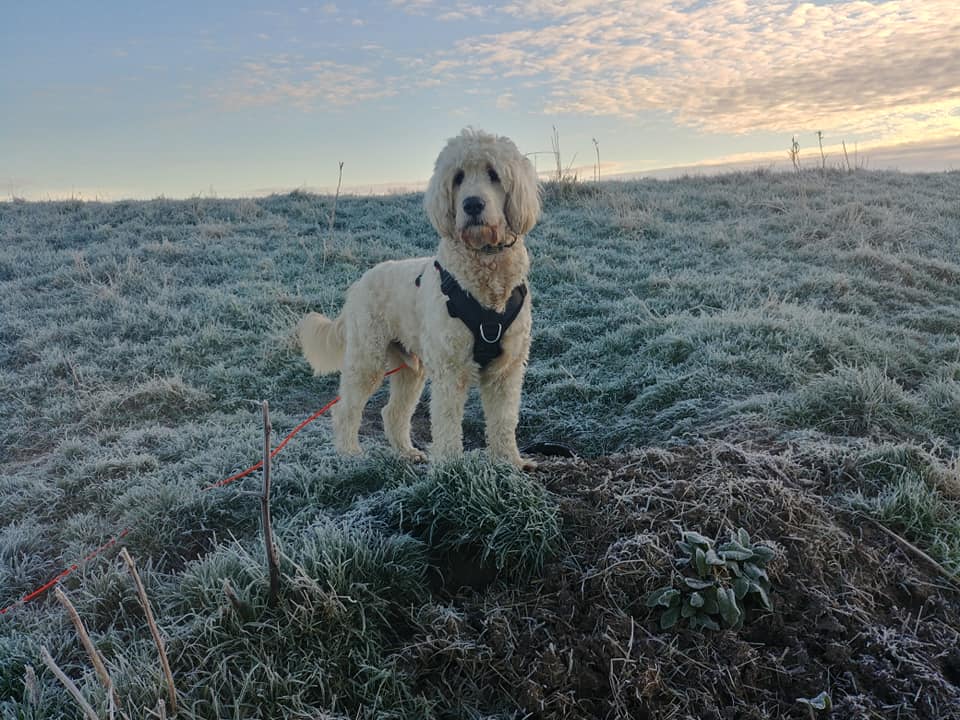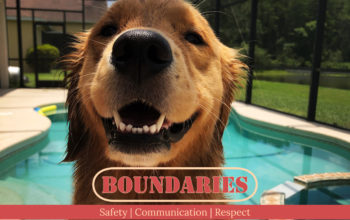When is a Walk More Than a Walk?
ALTHOUGH WALKING YOUR DOG IS A KEY PART OF TAKING CARE OF THEM, THERE IS A LOT MORE TO A WALK THAN JUST THE ACT OF WALKING. MANY OWNERS FORGET THAT THERE ARE MANY TYPES OF WALKS AND THAT IT IS OUR RESPONSIBILITY TO ENABLE OUR DOGS TO EXPERIENCE THESE.
Author: Dory Adelie
When someone says they’re going to walk their dog, you probably immediately think of them clipping their lead on their collar or harness and walking their dog around the block or taking them to a dog park or field. And that is of course walking your dog. But there is so much more to walking your dog than the process of literally walking them, and there are so many different ways it can be enriching for your dog.
The aim is to give your dog a variety of walks, in a mix of locations, with some structured, some more ‘free’, in order to make sure your dog is getting the most out of your walks. Some walks are designed to be a total adventure for your dog, others aim to develop important skills.
Meeting your dogs needs by giving them the variety and enrichment that they need on top of the physical activity, means that your dog will be more content, healthier and more able to give back to you in the way that you may well be wanting.
Before Leaving the House
Does this sound familiar? You say “time for walkies!!!” excitedly or ask your dog “do you want to go out?!”, cue your dog running around the house, spinning, jumping up and down, vocalising etc. And they continue to do that as you’re heading out the door and before you know it you’re being dragged down the street and trying to regain control of the situation.
How you approach leaving the house has a significant effect on how your walk starts. A key part of this is maintaining a calm demeanour and not leaving the house until your dog(s) are calm as well. Overexcitement isn’t actually that enjoyable for a dog as they are too hyped up to really engage in what’s happening, and are therefore less likely to get what they need from any type of walk. It is preferable to do as much of your preparation for leaving the house discretely and calmly and leaving the ultimate “cues” of it being a walk (e.g. putting on a lead or harness, and putting your shoes on) until just before you leave.
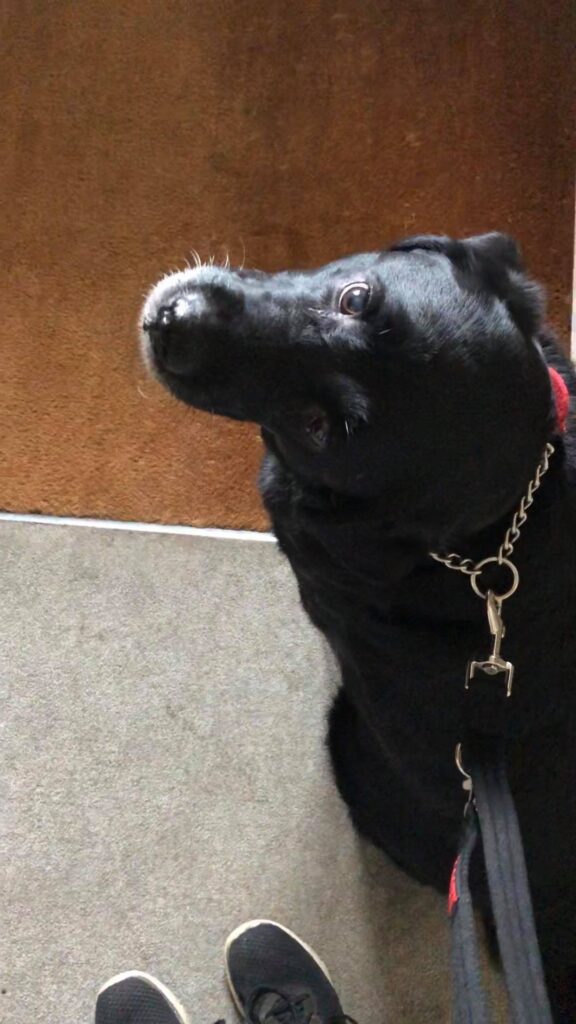
Dolly focusing and waiting calmly 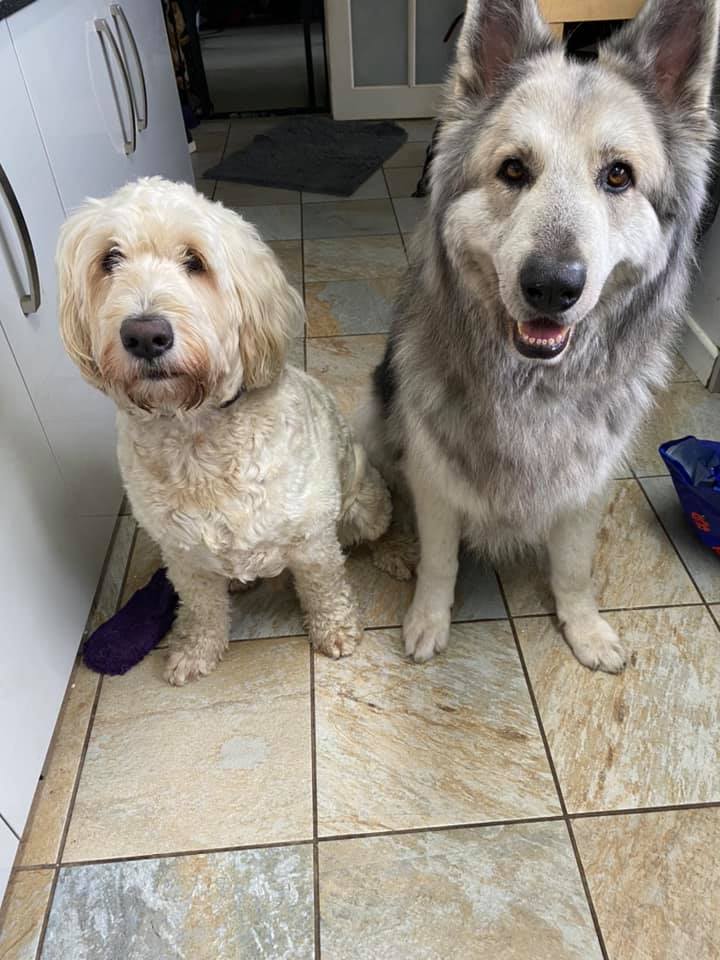
Buck and Kanook sitting calmly waiting
Getting your dogs to sit a little way away from the door itself can be beneficial to prevent the issue of pushing to get out the door, and also means you’re not being dragged as soon as you leave. It gives you a chance to get into position for heeling which is recommended to be the start of most walks as it is focused and really fostering that engagement with your dog.
It might take 5 (or even 10) minutes extra to be in a suitable position to actually leave the house, but it is so worth it for the rest of the walk!
Structured Leash Walk
This is one of the most vital types of walk for dogs of all ages, but often overlooked due to the effort and input required by the handler. With a structured leash walk, the goal is usually heeling in position, getting on top of any pulling (or dragging) issues and therefore may be a bit stop-start. It is worth giving your dog a chance to toilet at the start of the walk so they are not agitated and stressed, however avoid ‘hanging around’ with this type of walk, as it is a purposeful walk.
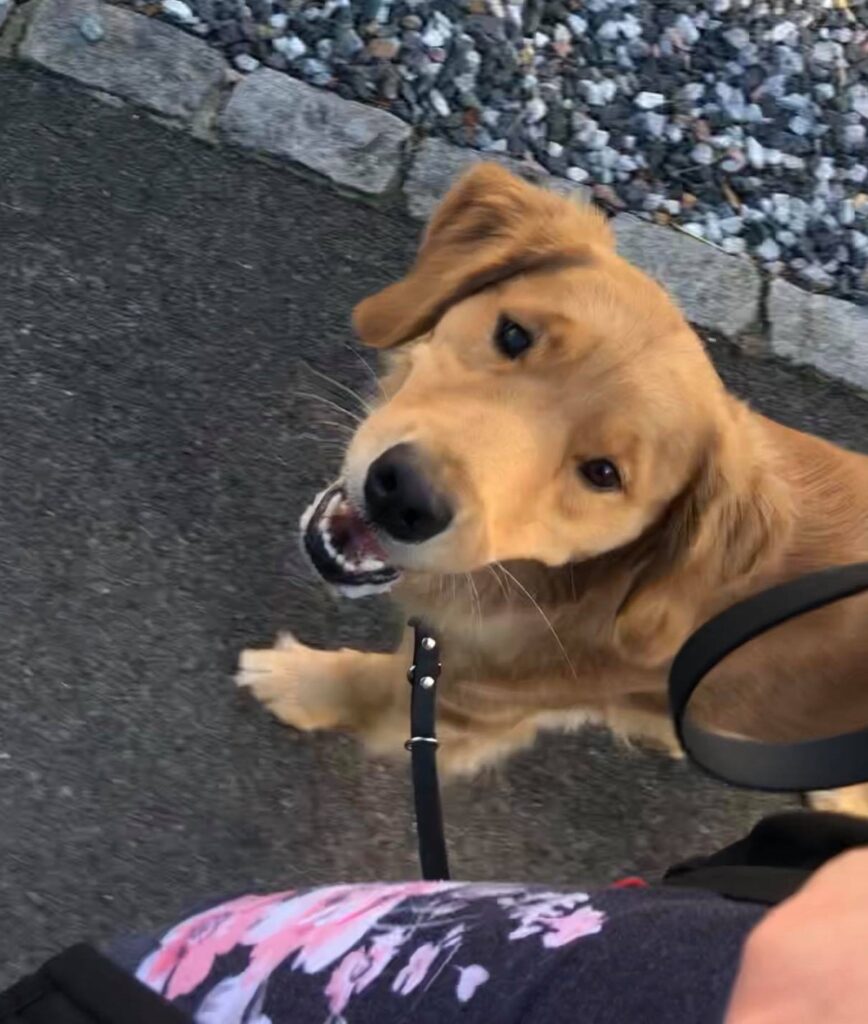
During this type of walk, the goal is not for your dog to meet other dogs, especially as greeting dogs while on the lead can result in frustration and reactive behaviour. If necessary, navigate around them and use it as a chance to get your dog’s attention around distractions. This therefore also isn’t really the sort of walk for you to chatter with your dog walking friends, so if need be choose a different route.
A structured leash walk is suitable for round residential roads on pavements etc. so is perfect if you live in an apartment or only have easy access to streets. It is remarkably tiring and mentally draining for your dog, so don’t take the fact that they aren’t running around off leash to mean that they haven’t had exercise. If you are able to keep the pace up, that also helps, and gets some bonus aerobic exercise in for you too!
If your dog generally walks nicely on a loose leash then you might want to just try little things like slowing and speeding up, requesting focus, and occasional pausing to sit or other basic commands.
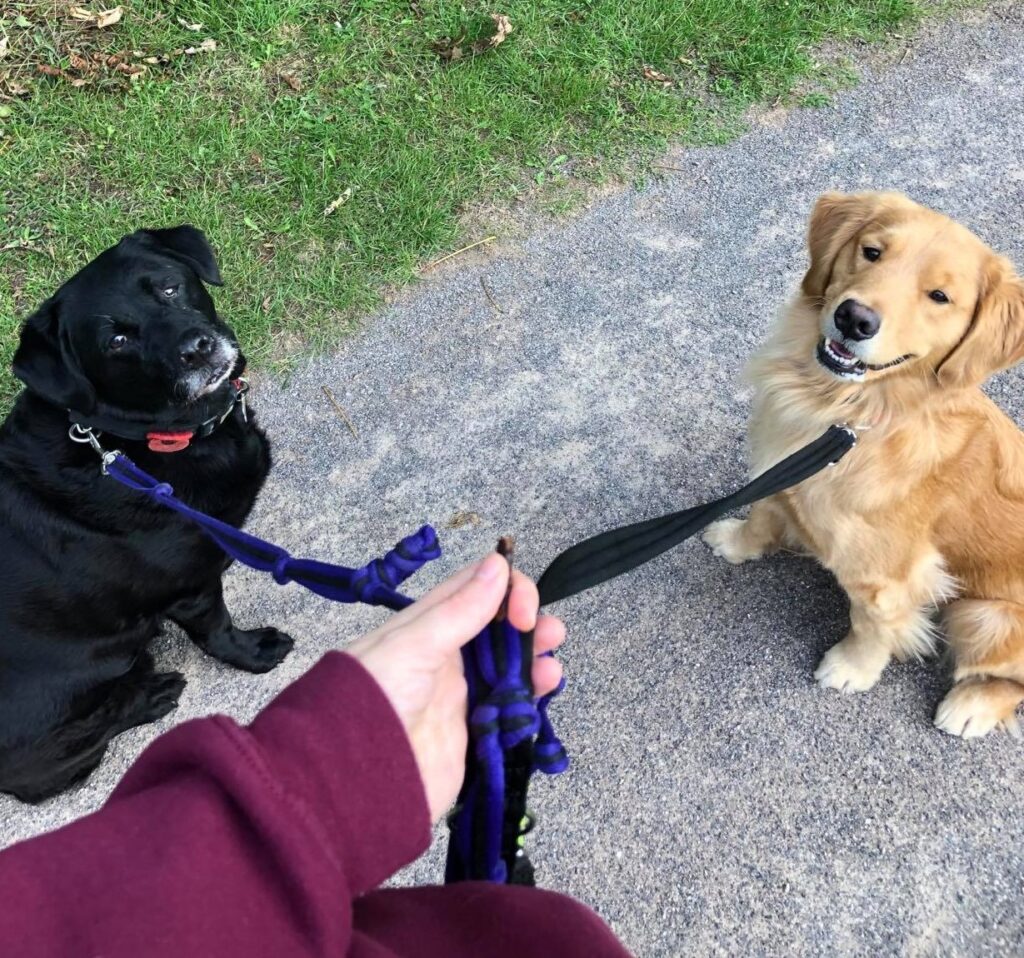
Depending on your confidence and ability as a handler/owner, you may take multiple dogs on your structured leash walk. Note that doesn’t mean it is a social walk, it is still purposeful and about the walk itself, involving calmly walking next to each other. If they aren’t able to do that yet, it is best to walk them one at a time.
Sniffari
Did you know? Dogs can have up to 300 million olfactory receptors in their noses, compared to just 6 million in humans. A hefty portion of their brain is devoted to processing and analysing smells and as such they understand and navigate their world through their sense of smell. Therefore it is important to allow them to investigate using their nose, so a walk/part of a walk dedicated to sniffing is a fantastic way to let your dog truly “be a dog”.
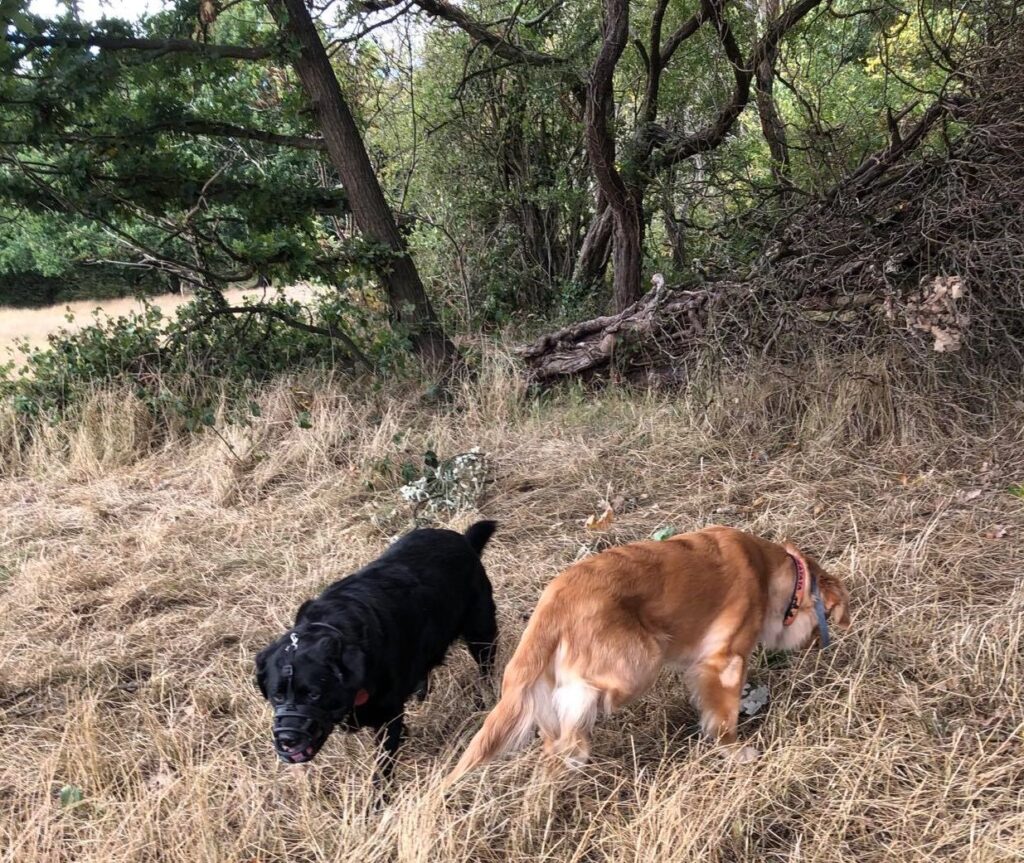
A dedicated outing for sniffing is often called a sniffy walk or “sniffari” (ie a Safari of sniffing). It is essentially exploration for your dog and this is truly enriching for them, as well as being both physically and mentally draining. While sniffing may look simple, so much is going on for them as they do it and they get so much information from each odour. If they want to spend a long time sniffing a particular area, then let them! This is not a walk where it is about you, it is about your dog. As such, you might not get very far and it might take a while but this is not a time pressured walk!! Especially if there are some truly interesting smells around, which your dog might decide there are. Grassy areas are fantastic for this.
For most dogs, this is best done on a long-ish lead so they aren’t having to strain to smell, and the goal is for you to follow where they would like to go (obviously within reason – safety is key!) Some people use a long lead attached to harness to indicate that it is a sniffari style walk and use a leash attached to the collar for a structured heeling walk – to communicate the difference.
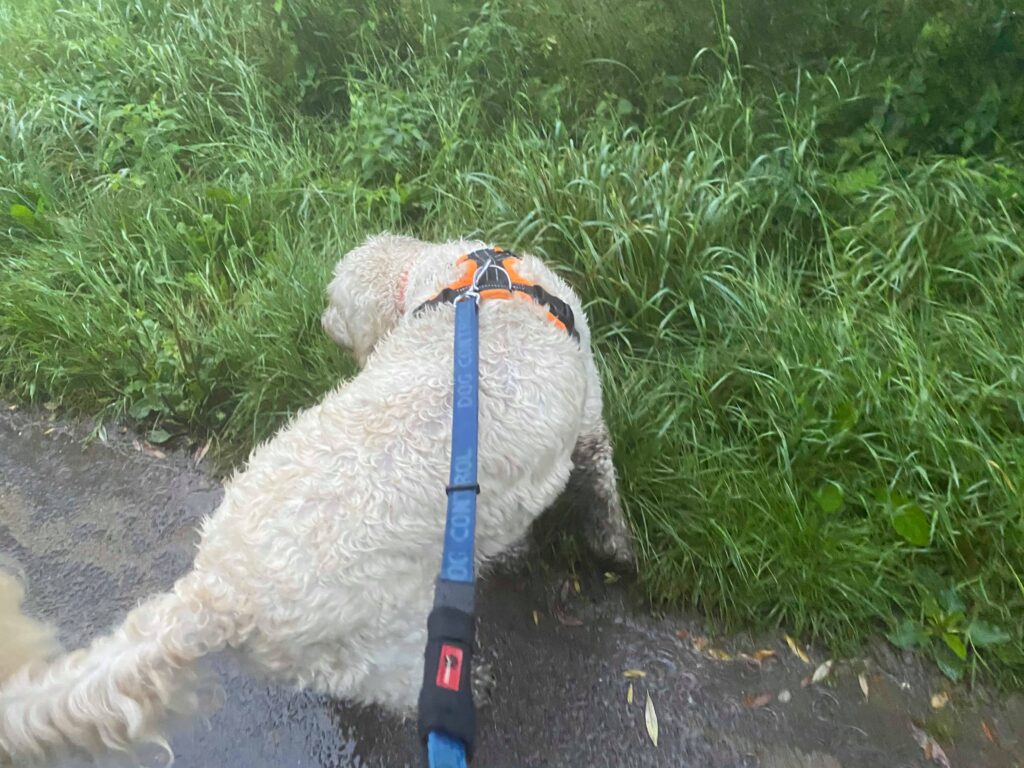
If you struggle with frustration with this sort of walk, try using it as an opportunity to practise having patience and also to take in your surroundings, while your dog takes in theirs. To avoid boredom on your part, it can be worth taking them to different places to do this so you can take in the scenery as well.
Free Roaming Walk
Free roaming is all about the dog getting a chance to decide where they’re going and is perfect for contained fields where they are able to investigate all sorts of things. This is suitable for dogs to do with other familiar dogs and they may choose to play, but are not pushed into a situation that forces them to interact if they don’t want to.
Note that I call this “free roam walk” not “off leash walk” – that is because being off leash is not a safe option for every dog. Whether it is because recall is not reliable, or their prey drive is extremely strong etc. or they are reactive, for some dogs being off leash is simply not safe, in any situation. It is perfectly okay for many dogs to not be fully off leash at any point while out and about. Strong long line leads are a great option for this, and they are a great safety net if you are trialling introducing off-leash work by dropping them briefly and allowing them to drag.
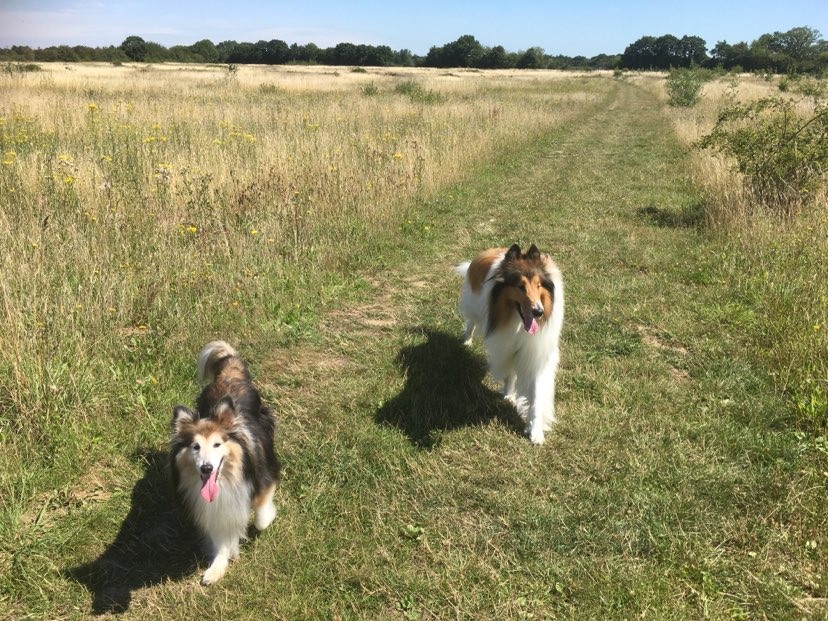
For everyone’s safety; do not choose places with livestock or land that you do not know it is ok to have your dog off lead or free roaming, and avoid places near roads or traffic.
Playtime/Social Walk
This is where your dog gets to interact with other dogs – if it is suitable for them to do so. You may choose not to do this sort of walk, especially if your dog has reactivity issues or you do not have good experiences with other dogs. This is a matter of knowing your dog and knowing yourself. In some situations, letting your dog interact with dogs that you don’t know is a recipe for disaster. However dogs do benefit from interactions with other dogs, providing they are safe and balanced. For a lot of dogs, going on a walk/play walk with familiar dogs is a good compromise – this way they get to interact with their canine peers but without the unknown factors of strange dogs (and for you, strange humans).
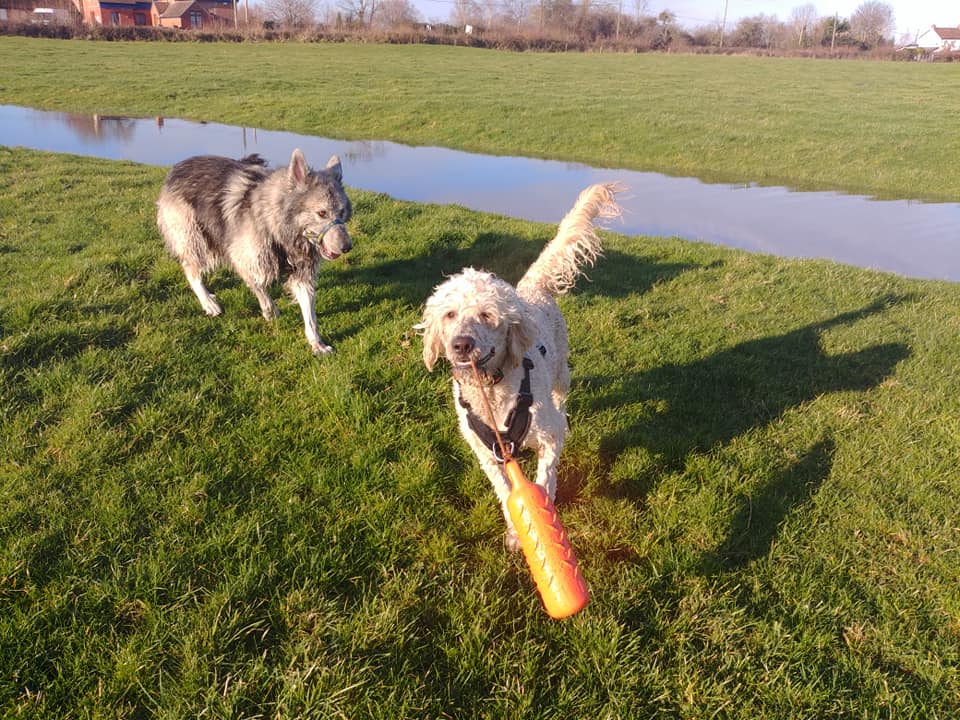
In this situation, the dogs being on the lead is not beneficial, so it is best done in secure places where they can be free to play without leash restriction but not in small spaces as this can leave some dogs feeling trapped. This is why typical “dog parks” found in the US and in some other urban areas have bad connotations as they are often very small spaces, leaving dogs feeling stuck in confrontations and more prone to reacting negatively.
Although the dogs may be playing etc., it is important as owners to take the responsibility to watch and monitor their play carefully. This isn’t the time to switch off or take a phone call, as you may need to step in and advocate for your dog, or alternatively call them off. In order to allow this sort of social/play interactions, it is helpful to have a good general understanding of good manners and the signs of when a dog is being too pushy, or is feeling uncomfortable. Also, it is important to know your dog and how they communicate, when they’re getting overwhelmed etc. It might be that your dog is fine to play with others until a ball is involved, so at that point you may want to call your dog to you and get moving, or alternatively remove the ball from play. It is a good idea to give breaks and allow down time when dogs are playing together.
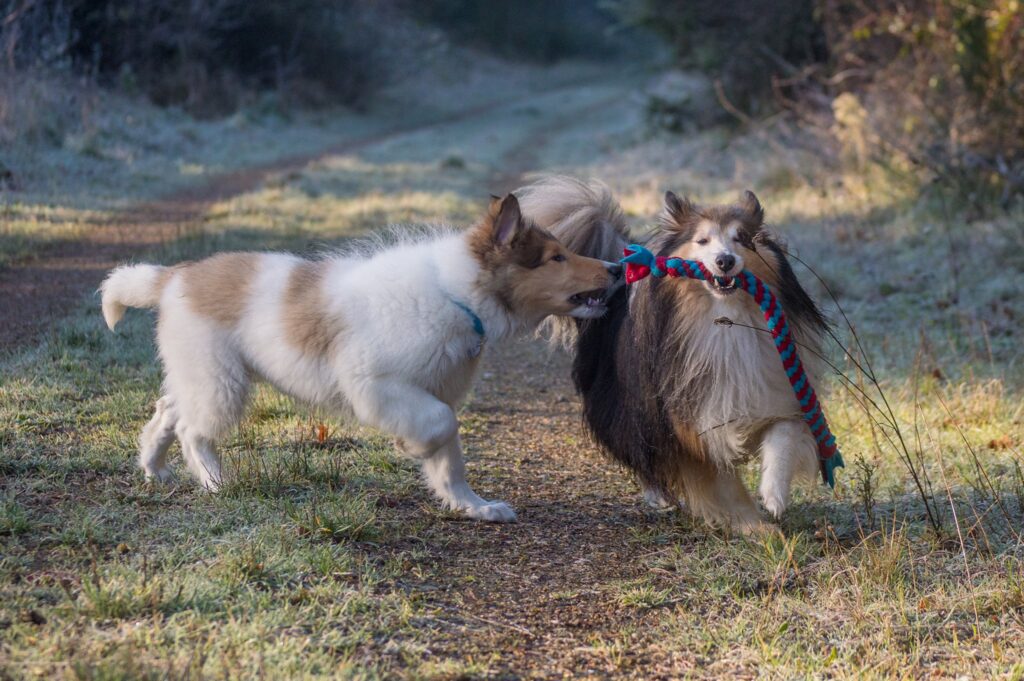
If your dog goes to doggy day care or out with a dog walker, it is possible they have this sort of interaction and you may well notice they are exhausted afterwards. That is because the socialising combined with often very active play is both mentally and physically tiring. To get an idea of this, if you go to a party, you probably end up feeling pretty tired when you come home!
Training Walk
Not all dogs and owners will go on this sort of walk; for the average pet owner the structured leash walk acts as a training walk – working on heeling and maybe some basic obedience. However those who take part in sports, competitive obedience or who have assistance dogs, may wish to take their dog on a dedicated “training” walk. This will be something different for each person and dog, and often vary from one session to another.
In many cases it is practising a trick, command or behaviour they have learnt, and applying it in a more complex setting e.g. adding distance or distractions. Being outside itself is distracting due to the amount of sights and smells around that aren’t indoors. Equally things like distance downstays can be particularly challenging if a bird appears out of nowhere. A lot of the time it is testing impulse control, focus and discipline – skills which are key in these sports and in Assistance work.
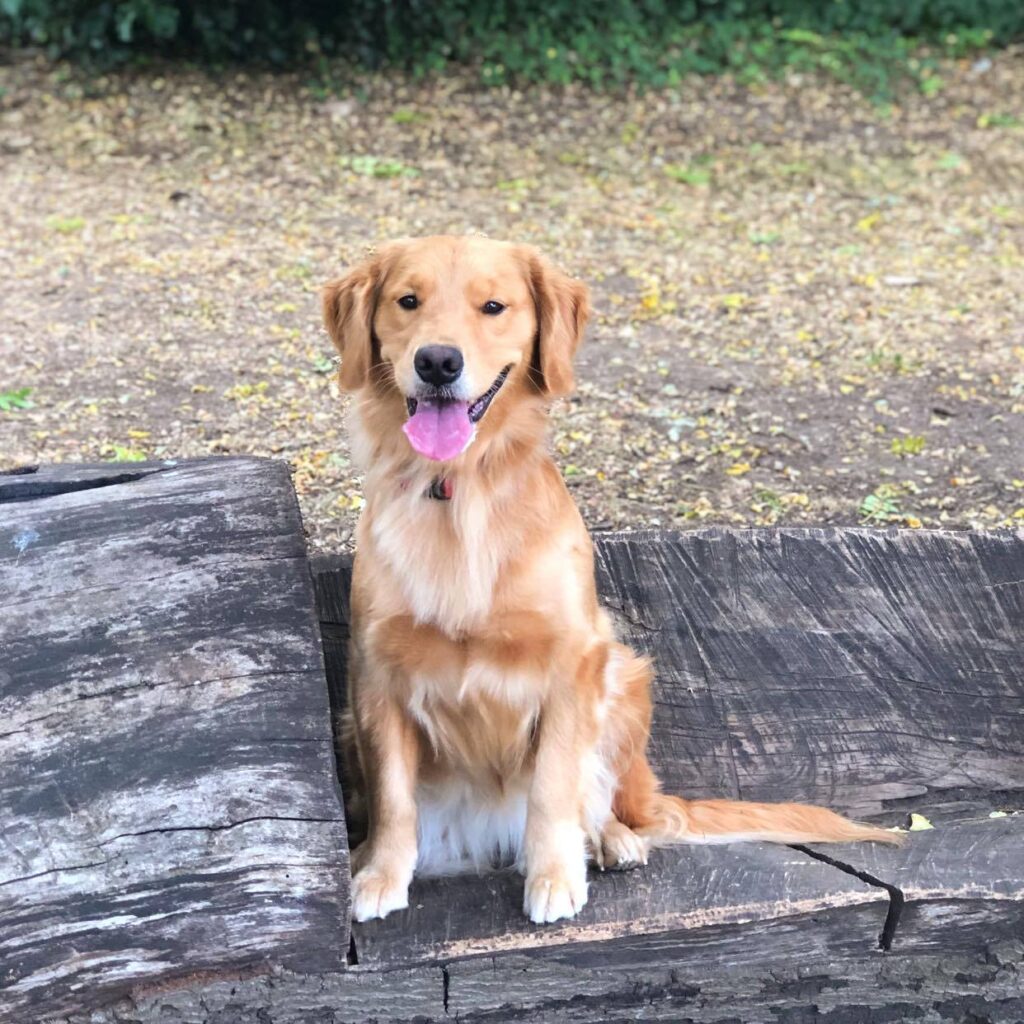
The difficulty of a trick, command or behaviour may be increased and therefore the dog’s obedience and ability tested by being outside. A good example of this is an emergency stop – throwing a ball then calling an emergency stop (where they must halt immediately, and in some cases “drop” down) can be even more challenging when done in a field, a place often associated with free chasing of a ball. The same applies with practising recall. This sort of thing can be a matter of life or death, so assessing the reliability of these behaviours in a “real life” setting is important for safety.
Sometimes, in the case of sports like disc dog and agility etc., the training walk can be building confidence and ability in the skills involved – for example jumping up and balancing on a tree stump or practising rebounds off trees etc. Some activities are just better suited to outdoors practice!

Where I said for free roaming walk that it was not an off leash walk, for some it may be. However for others, an off leash walk is a training walk. In this case it is likely to be punctuated with bursts of off-leash heeling, recalls, navigational commands etc. to ensure these actions can be performed off leash with distractions. Equally parts of a training walk may involve a dropped leash e.g. to do down stays, sit stays or recall from a static position.
Activity
Finally there is the “not so much of a walk” walk. This is more about the activity involved and the walk, usually to get there and back, is really circumstantial. A good example of this is going somewhere that your dog can go swimming etc. Bear in mind with this sort of walk that swimming is remarkably exhausting for your dog, so you may need to shorten the session even if they seem to be having loads of fun. And of course, watch out for water intoxication.
Other examples are dedicated enrichment paddocks/fields, agility courses or dog sports like bikejoring.
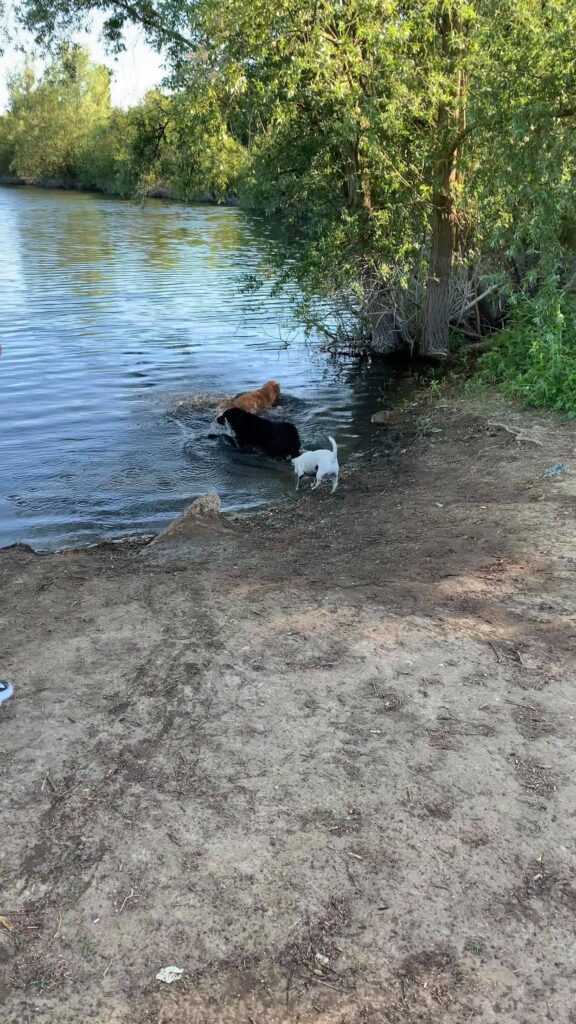
Sparrow & friends swimming 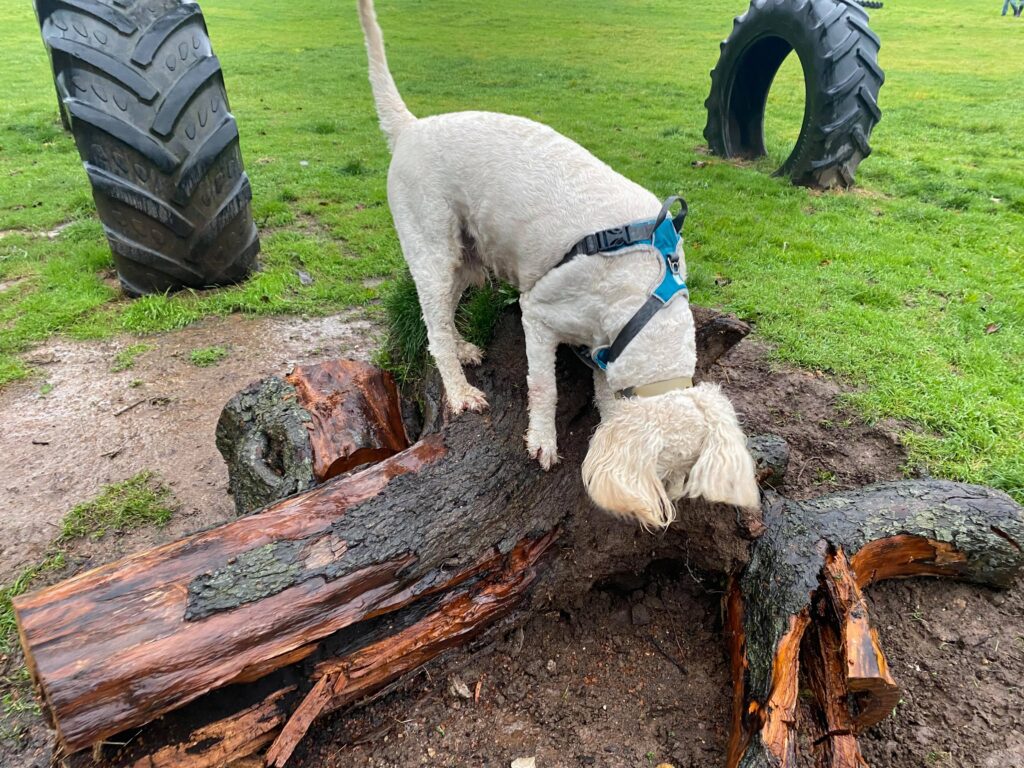
Buck at a dedicated enrichment location 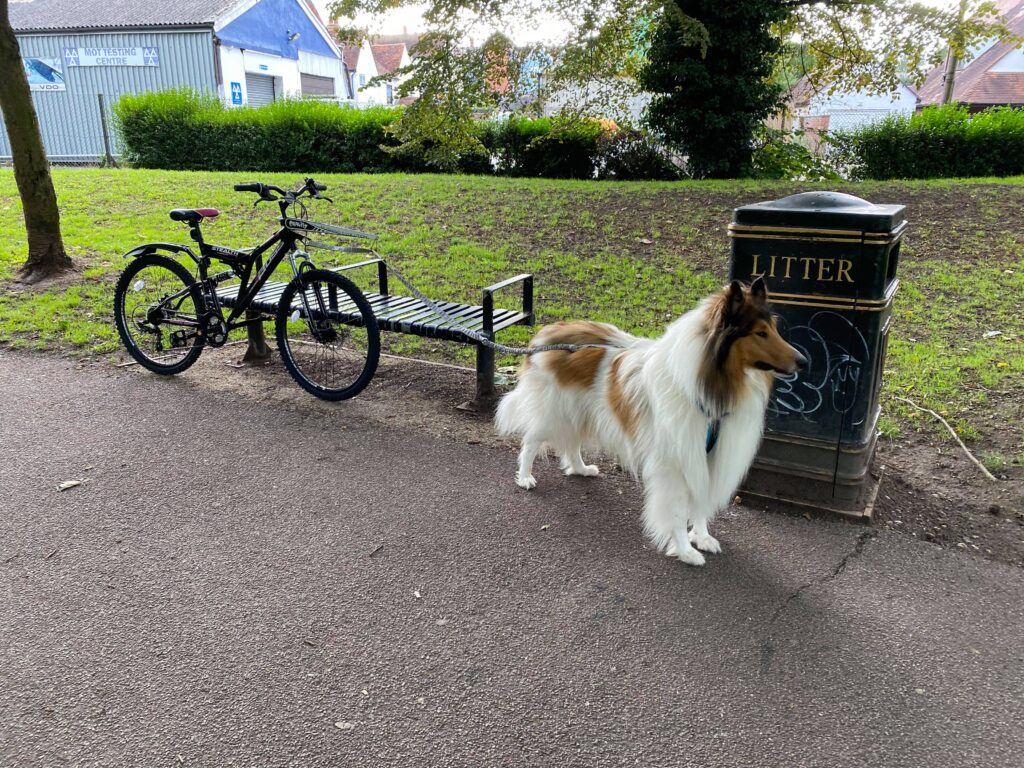
Po out bikejoring


